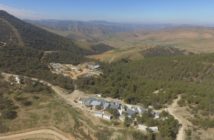Ruth Fremson/The New York Times
Abderrazak Bahij and other craftsmen from Morocco at work on the arches in a courtyard being created at the heart of the Islamic art galleries of the Metropolitan Museum of Art. More Photos »
Published: March 17, 2011
WHEN the Metropolitan Museum of Art makes a big curatorial decision, it tends to do so with the kind of grave deliberation that goes into a papal bull. Gut feeling is not a prized consideration. But in the spring of 2009, in a dust-covered basement workshop in Fez, Morocco, a young curator in the museum’s Islamic department sat among a group of artisans — workers in traditional North African tile, plaster and wood ornament whose roots stretched back seven generations in the trade — and asked the company’s chief executive yet again why the museum should enlist them for an unusual mission.
The executive, a boyish-looking man named Adil Naji, reached over and took hold of the wrist of one of his younger brothers, Hisham. He hoisted the brother’s rough, callused fingers in front of the curator, Navina Haidar, and, with a climactic intensity that wouldn’t have been out of place in “Lawrence of Arabia,” exclaimed, “Look, this is my brother’s hand!”
As Ms. Haidar recalled recently, back in the much less cinematic confines of a museum construction site: “It was a very powerful moment. It made up our minds because we could see how close he was to the tradition. And we wanted to see that hand on our walls.”
She and her colleagues had gone to Morocco in search of help for a kind of project that the Metropolitan, which generally concerns itself with the work of dead artists, has rarely undertaken in its 140 years: to install a group of living artists inside the museum for the purposes of creating a permanent new part of its collection.
The last time such a thing happened was in 1980, when Brooke Astor underwrote the re-creation of a Ming dynasty garden courtyard, made by more than two dozen master builders from Suzhou, China, who spent four months on the job within the museum’s Chinese painting galleries, working with hand tools unchanged for generations.
Almost 30 years later the museum was embarking on the most ambitious rethinking and rebuilding of its Islamic art galleries in its history, a $50 million endeavor. At the heart of those galleries, which will open in the fall after being closed six years, it dreamed of showcasing the defining feature of Moroccan and southern Spanish Islamic architecture: a medieval Maghrebi-Andalusian-style courtyard, which would function in much the same way such courtyards still do in the traditional houses and mosques of Marrakesh or Casablanca, as their physical and spiritual center.
The problem was that, while the museum owns entire blocks’ worth of historic architecture, it did not happen to have a medieval Islamic courtyard sitting around in storage anywhere. And so after months of debate about whether it could pull off such a feat in a way that would meet the Met’s standards, it essentially decided to order a courtyard up.
Which is how a group of highly regarded Moroccan craftsmen, many of whom had never set foot in New York, came essentially to take up residence at the Met beginning last December, working some days in their jabador tunics and crimson fezzes (known as tarbooshes in Morocco), to build a 14th-century Islamic fantasia in seclusion high above the Greek and Roman galleries as unknowing museum goers passed below.
With world attention focused on the Middle East, the courtyard has taken on an unforeseen importance for the museum; for the Kingdom of Morocco itself, which has followed the project closely; and for a constituency of Muslim scholars and supporters of the Met. They hope it will function not only as a placid chronological way station for people moving through more than a millennium of Islamic history, but also as a symbol, amid potent anti-Islamic sentiment in the United States and Europe, that aesthetic and intellectual commerce remains alive between Islam and the West.
“Every one of these guys here knows what this means, what’s riding on this,” said Mr. Naji, 35, the president and chief executive of Arabesque, a company of craftsmen founded in Fez in 1928 by his great-grandfather, now run by Mr. Naji and three of his brothers.
It was late December, and he was gesturing across a cluttered, unadorned room that didn’t look like much of a symbol, much less a reimagined medieval courtyard, except for high metal armatures suggesting the forms of arches. Mr. Naji’s brother Hisham, 33, of the callused and persuasive hand, stood atop a scaffold covered in plaster dust. Below him, covering a swath of the floor, lay tens of thousands of pieces of clay tile, many not much bigger than grains of rice, fitted together face down in a big rectangle that looked like a shallow sandbox scored with impossibly intricate lines. The tiles had been shipped from Fez, where [youtube http://youtube.com/w/?v=QEW0RWQqnyc” title=”A video of Adil Naji showing how they are made, in French] and then hand cut into individual shapes by 35 workers over a period of four months.
Inside the Met that morning an Arabesque specialist in [youtube http://youtube.com/w/?v=swceVsrK5eM” title=”A video of the Moresque craftsmen at work], known as zellij, sat cross-legged, placing some of the final pieces into the arrangement with tweezers as another scattered dry grout between the tiles. Handfuls of water were then sprinkled like ablutions over these areas to begin to cement the pieces in place. And when it was all dried, the dado panel was hoisted up into its place along one of the courtyard walls, filling the room for the first time with the kind of kaleidoscopic color and tessellated patterning meant to transport visitors from Fifth Avenue to Fez. (The tiles’ traditional function is to soften the solidity of the walls. “The surface is seemingly dissolved,” Jonas Lehrman, an architectural scholar, wrote in “Earthly Paradise: Garden and Courtyard in Islam,” a 1980 study. “Yet throughout the entire organization, even the smallest units are related by the overriding discipline of the geometry.”)
Over the course of two months a reporter and photographer were invited to watch as the space began to transform slowly from a 21-by-23-foot drywall box — illuminated by an LED panel in the ceiling cleverly mimicking daylight — to a courtyard with tile patterns based on those in the Alhambra palace in Granada, above which rise walls of fantastically filigreed plaster, leading to a carved cedar molding based on the renowned woodwork in the 14th-century Attarin madrasa, or Islamic school, in Fez.
The men from Morocco, 14 in all, came in waves, and despite suffering through their first New York winter, they settled comfortably into two large condominiums in Jackson Heights, Queens, accommodations that Adil Naji persuaded the owner, a Lebanese man, to lease to them, even though it was a nonrental building, by describing their mission at the Met. The men hired a local Moroccan woman to cook for them, and every morning they carry their kebabs and couscous in lunch boxes to the Met.
Occasionally New York still throws a curve ball or two. After a recent breakfast in Queens with the company’s lawyer, the men made their way to the No. 7 train, and the oldest Naji brother, Mohammed, 40 — the family’s most revered craftsman, a maalem, or master carver — was almost arrested after his monthly Metrocard failed to swipe properly, and he simply walked through an open emergency gate. On the subway later, wearing his customary street clothes — pointy-toed cowboy boots, baseball cap, a baby-blue fur-lined jacket — he seemed unperturbed, smiling broadly.
Adil Naji, who went to college in Washington and speaks perfect English, asked his brother how he could be so calm, and then translated the answer: “He said: ‘I had a lawyer, a reporter and a photographer with me. What was going to happen?’ ”
Sheila R. Canby, who was recruited two years ago from the British Museum to lead the Met’s Islamic department and oversee the renovation of the galleries, said that the back and forth between the craftsmen and the curators had sometimes been tumultuous. The Moroccans, who are known for their restoration work on important mosques and other landmarks in the Middle East, are in essence living historians who have carried on patterns and designs preserved in practice for generations. But they have never attempted a job requiring this level of historical attention or artistry, one whose goal is to look as authentic to Moroccan eyes as to those of scholars.
“We have been very difficult clients, sending drawings back over and over again,” Ms. Canby said recently, watching the men work. “We didn’t want any intrusions of modern interpretation.”
Ms. Haidar added, “They’d say to us, ‘But our great grandfathers did it this way,’ and we would tell them, ‘We’re taking you even further back into your history.’ ”
Adil Naji, listening in, shrugged his shoulders diplomatically. “It was fun to go back and forth,” he said.
Ms. Canby laughed out loud: “You say that now.”
Perhaps almost as remarkable as the presence of the craftsmen inside the Met is that the team of scholars and planners who recruited them and have collaborated closely with them is composed mostly of women, one of them Israeli. Besides Ms. Canby and Ms. Haidar, the group includes Nadia Erzini, an art historian and curator at the Museum of Islamic Life in Tétouan, Morocco; Mahan Khajenoori, from the museum’s construction department; and Achva Benzinberg Stein, an expert on Moroccan courts and gardens and a professor of landscape architecture at City College.
On a recent visit to the museum Ms. Stein became emotional surveying the work under way, describing how she had fallen in love with books about Moroccan architecture as a young woman in Tel Aviv but had been unable to travel there until the mid-1970s because she was Israeli. “This is like the culmination of a life’s work for me,” she said, wiping away tears. “To me it means the possibility of so many things, of peace.”
By late February inside the courtyard the wall tile work had been completed, and the woodwork, as redolent as a cedar closet, had been mostly installed. Still to come before the opening in the fall would be a specially designed self-circulating fountain and benches designed by Ms. Stein.
Mohammed Naji and seven other plaster carvers had just set to work on the most painstaking part of the job, incising interlaced patterns into the still-soft wall, arabesques and other forms so tiny and complex that each man can sometimes complete only a four-inch square over the course of a day.
“This kind of work is really not done anymore in Morocco — it’s too time consuming, too cost prohibitive,” Adil Naji said, watching his eldest brother sitting on a stool, peering over a pair of reading glasses, carving with a thin wood-handled knife and pausing metronomically every few seconds to lean forward and blow the dust from the crevices.
Mr. Naji beamed, but he conceded, as he watched the company’s greatest work taking shape, that one thing worried him.
“Two of my guys told me that they wanted to retire after this, because they couldn’t see a way to top it,” he said. “I wake up at night with this fear that when we’re done, they’re all going to stand back and look at it and hang up their tools for good.”







